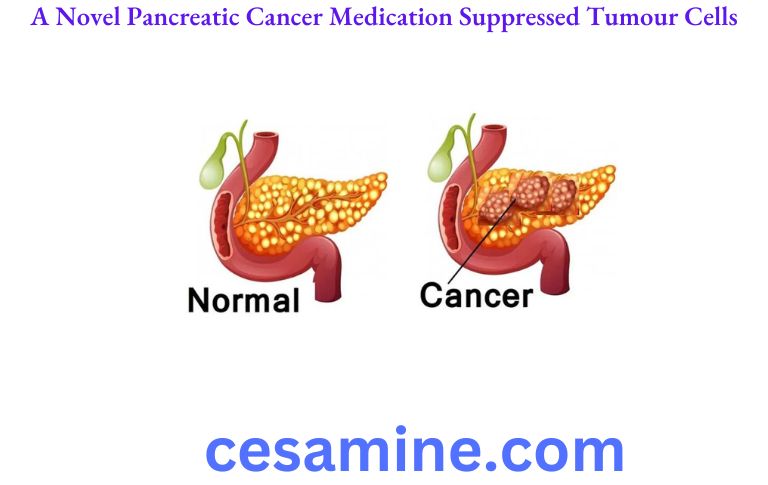A novel pancreatic cancer treatment successfully decreased the amount of malignant cells.
Pancreatic cancer is extremely tough to cure due to the tumor’s high cell barrier that protects it from cancer medications and therapies. However, the newly tested medicine was able to kill an unusually significant number of tumour cells.
Pancreatic cancer is very difficult to cure because tumours are surrounded by a strong cell barrier that protects them from anti-cancer medications as well as the body’s immune system.
These barrier cells also aid in the spread of cancer throughout the body, making the creation of curative medicines more difficult. The study’s primary results were that the novel medication CRO-67 destroyed both tumour cells and barrier cells in samples collected from six individuals who had malignancies surgically removed.

New evidence from a pancreatic cancer medication is encouraging.
Noxopharm Limited, an Australian biotech business, has disclosed promising new preclinical findings from its long-term relationship with UNSW Sydney. The findings were presented this week in Boston at the American Association for Cancer Research (AACR) Special Conference on Pancreatic Cancer.
Noxopharm’s new preclinical medicine, which tackles pancreatic cancer in a novel and novel approach, is included in the research. The 18-month trial was done by Noxopharm as part of an ongoing cooperation with UNSW to examine a novel medicine created by the business known as CRO-67.
The number of tumour cells was reduced by 85%.
CRO-67 was administered to patient samples at dosages of 10, 20, and 50 micrograms per millilitre, and a dose-response relationship was discovered, indicating that increasing levels of the drug resulted in highly statistically significant effects.
The number of tumour cells was cut in half, whereas the number of barrier cells was cut in half. Cell replication was inhibited by 73%, while overall cell death rose by 6.2 times.
This capacity to target both kinds of cells may open the way for a novel treatment known as “dual-cell” therapy, which recognises the new drug’s unique features and method of combating pancreatic cancer.
The researchers employed a novel model created by UNSW that develops entire tissue tumours and pancreatic tumour cells, as well as barrier cells, which were maintained alive in the lab for 12 days after being surgically removed from cancer patients.
Tumor samples were then treated with CRO-67 and analysed under as realistic settings as feasible.
Pancreatic cancer and the search for better therapies
There is an urgent need for new effective therapies for pancreatic cancer, which will be the second largest cause of cancer mortality in the United States by 2030, with a five-year survival rate of just 9% from the time of diagnosis.
“The findings demonstrated that CRO-67 has the potential to enhance patient outcomes via targeted ‘bicellular’ activity that may directly attack tumour cells while also killing ‘helper cells’ in the tumour environment .
Traditional chemotherapeutics in this region only target tumour cells, not the surrounding supportive cells, and hence their therapy efficacy is quite limited,” says UNSW’s Phoebe Phillips.
Pancreatic cancer and the neglected market for cancer medications
“The creation of novel medicines is an important component of our extended drug development strategy, and we are thrilled that Chroma is showing such promising early findings.”
This research is fascinating because it is the closest we’ve gotten to examining human cancer in the lab before administering the medicine to patients. We’re still in the early stages, and there’s a lot of work to be done, but we’re on an exciting trip.
“The pancreatic cancer medicine market is large and obviously underserved, representing a great potential for Noxopharm,” stated Noxopharm CEO Gisela Mautner.
More research on CRO-67’s therapeutic effectiveness is presently being conducted, as well as a deeper examination of the processes by which CRO-67 exerts its “dual cell” targeting effects. A number of additional investigations will be required to support the research required to advance CRO-67 into clinical trials.
- Understanding Anal Cancer: Symptoms, Diagnosis, and Treatment
- Understanding Anaplastic Thyroid Carcinoma: Symptoms, Diagnosis, and Treatment
- Understanding Cancer Stages: What They Reveal About Your Disease
- Understanding Head and Neck Cancer: Symptoms, Causes, Risk Factors, and Treatment Options
- Understanding Heart Cancer: Symptoms, Causes, Diagnosis and Prevention
- Understanding Non-Lymphoma Hodgkin’s: Symptoms, Causes, and Treatment
- Understanding Pancreatic Cancer: Symptoms, Risk Factors, and Early Detection
- Understanding the Risks of Ovarian Cancer and How to Stay Safe
- Understanding Vocal Cord Cancer: Symptoms, Causes, Diagnosis, and Treatment
- What Are The Additional 12 Cancer Symptoms And Signs?
- Cancer Deaths More Common Among Older Adults With Type 2 Diabetes
- Cancer Stem Cells Are Fueled Through Dialogue With Their Environment
- Bladder Cancer Takes a Toll on Mental Health. Here’s How to Cope
- Cancer Remission: Understanding Partial and Full Remission, Causes of Recurrence, and Care After Remission
- Lung Cancer: Understanding the Three Most Prevalent Forms and Treatment Options
- Plant-Based Diet Tied to Lower Bowel Cancer Risk in Men